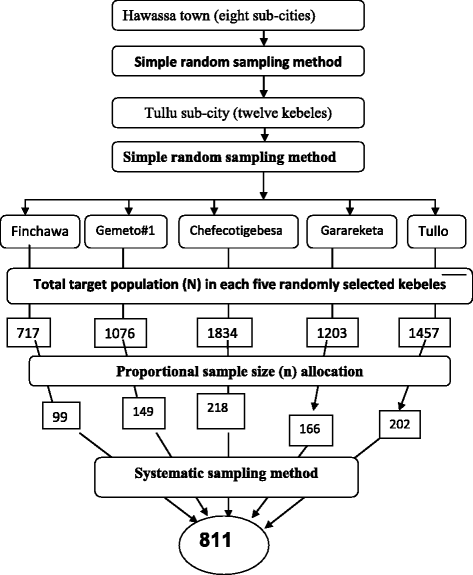Magnitude and predictors of undernutrition among children aged six to fifty nine months in Ethiopia: a cross sectional study
- PMID: 28694966
- PMCID: PMC5502324
- DOI: 10.1186/s13690-017-0198-4
Magnitude and predictors of undernutrition among children aged six to fifty nine months in Ethiopia: a cross sectional study
Abstract
Background: Undernutrition among children continues to be a major public health problem in developing countries. In Ethiopian, 44% of under-five children were stunted while 29% and 10% were underweight and wasted respectively. However, predictors of undernutrition among children were not clearly known in the study area. Therefore, this study was aimed at determining prevalence and predictors of undernutrition among children aged 6-59 months in Hawassa town.
Method: A community based cross-sectional study was conducted among 811 randomly selected children paired with their mothers/caregivers. Mothers/caregivers were interviewed to obtain social-demographic data and feeding practice. Anthropometric measurement was conducted to obtain anthropometric data. Data were entered into EPI info 6.04 and exported to SPSS 16 for analysis. Bivariate logistic regression analysis with Crude Odds Ratio at 95%CI was used to assess presence of association among variables. Multivariate logistic regression analysis with Adjusted Odds Ratio at 95%CI was conducted to determine predictors of undernutrition and association was declared significant at p ≤ 0.05.
Result: The result of our study indicated that 39.3%, 15.8% and 6.3% of children were stunted, underweighted and wasted respectively. Multivariate logistic regression analysis identified male sex, mother older than 35 years, not fed on colostrum, cessation of breastfeeding before two years of age, frequency of complementary feeding per day and diarrheal morbidity in the last 12 months were statistically associated with stunting. Maternal education, family sizes and diarrheal morbidity in the past 12 months were significantly associated with underweight. Similarly, frequency of complementary feeding per day, age at cessation of breastfeeding, preceding birth interval and not fed on colostrum were associated to wasting.
Conclusion: The prevalence of undernutrition; stunting, underweight and wasting, among under-five children is very common in the study area. Inappropriate feeding practice and diarrheal morbidity were found to be the main risk factors for undernutrition. Appropriate factor specific interventions including counseling on optimal child feeding practice and diarrhea prevention should be strengthened in the study area.
Keywords: Children; Stunting; Underweight and undernutrition; Wasting.
Figures
Similar articles
-
Prevalence of undernutrition and associated factors among children aged between six to fifty nine months in Bule Hora district, South Ethiopia.BMC Public Health. 2015 Jan 31;15:41. doi: 10.1186/s12889-015-1370-9. BMC Public Health. 2015. PMID: 25636688 Free PMC article.
-
Prevalence and associated factors of undernutrition among under-five children from model and non-model households in east Gojjam zone, Northwest Ethiopia: a comparative cross-sectional study.BMC Nutr. 2019 Apr 8;5:27. doi: 10.1186/s40795-019-0290-y. eCollection 2019. BMC Nutr. 2019. PMID: 32153940 Free PMC article.
-
Undernutrition and Associated Factors Among Children Aged 6-23 Months in Dessie Town, Northeastern Ethiopia, 2021: A Community Based Cross-Sectional Study.Front Pediatr. 2022 Jul 8;10:916726. doi: 10.3389/fped.2022.916726. eCollection 2022. Front Pediatr. 2022. PMID: 35874575 Free PMC article.
-
Undernutrition and associated factors among urban children aged 24-59 months in Northwest Ethiopia: a community based cross sectional study.BMC Pediatr. 2019 Jun 29;19(1):214. doi: 10.1186/s12887-019-1595-3. BMC Pediatr. 2019. PMID: 31255179 Free PMC article.
-
Prevalence and associated factors influencing stunting and wasting among children of ages 1 to 5 years in Nkwanta South Municipality, Ghana.Nutrition. 2023 Jun;110:111996. doi: 10.1016/j.nut.2023.111996. Epub 2023 Feb 9. Nutrition. 2023. PMID: 37003173 Review.
Cited by
-
The prevalence and associated factors of undernutrition among under-five children in South Sudan using the standardized monitoring and assessment of relief and transitions (SMART) methodology.BMC Nutr. 2021 May 28;7(1):25. doi: 10.1186/s40795-021-00425-3. BMC Nutr. 2021. PMID: 34044874 Free PMC article.
-
Understanding the Enablers and Barriers to Appropriate Infants and Young Child Feeding Practices in India: A Systematic Review.Nutrients. 2021 Mar 2;13(3):825. doi: 10.3390/nu13030825. Nutrients. 2021. PMID: 33801545 Free PMC article.
-
Prevalence of undernutrition and associated factors among children aged 6-23 months: a cross-sectional analysis from South-East Ethiopia.J Nutr Sci. 2023 Dec 27;12:e127. doi: 10.1017/jns.2023.109. eCollection 2023. J Nutr Sci. 2023. PMID: 38155807 Free PMC article.
-
The association of socio-demographic and environmental factors with stunting among under-five children in Hawassa City, Sidama National Regional State, Ethiopia.J Nutr Sci. 2022 May 5;11:e33. doi: 10.1017/jns.2022.29. eCollection 2022. J Nutr Sci. 2022. PMID: 35620765 Free PMC article.
-
The Burden of Undernutrition and Its Associated Factors Among Children Below 5 Years of Age in Bambao Region, Comoros.Front Nutr. 2022 Apr 26;9:885002. doi: 10.3389/fnut.2022.885002. eCollection 2022. Front Nutr. 2022. PMID: 35558747 Free PMC article.
References
-
- Oystein K, Ivy K. Children’s Stunting in Sub-Saharan Africa: Is there an Externality Effect of High Fertility? Demogr Res. 2011;25(18):565–94.
-
- Central Statistical Agency and ICF International . Ethiopia Demographic and Health Survey 2011. Addis Ababa: CSA and ICF International; 2012.
LinkOut - more resources
Full Text Sources
Other Literature Sources
Miscellaneous


